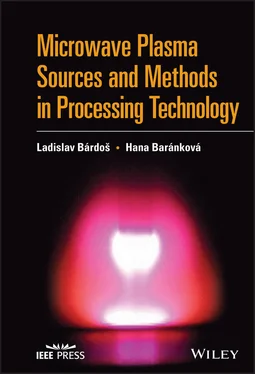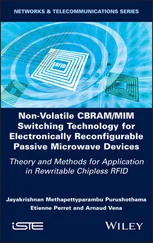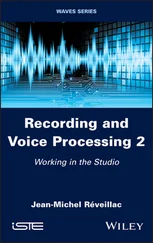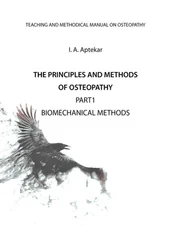6 Chapter 6Figure 6.1 Schematic of planar microwave plasma system utilizing...Figure 6.2 Examples of high-density low-pressure plasma systems based...Figure 6.3 An illustration of the experimental system for testing the thrust...Figure 6.4 Illustration of the experimental system for production of hydrogen-...Figure 6.5 An illustration of the experimental system for the graphene...
1 Chapter 1 Table 1.1 Comparison of the loss tangent values of selected materials...
1 Cover
2 Title page Microwave Plasma Sources and Methods in Processing Technology Ladislav Bárdoš and Hana Baránková Uppsala University, Uppsala, Sweden
3 Copyright
4 Table of Contents
5 Foreword from the Authors
6 Begin Reading
7 Index
8 End User License Agreement
1 i
2 ii
3 iii
4 iv
5 v
6 vi
7 vii
8 viii
9 ix
10 x
11 xi
12 xii
13 1
14 2
15 3
16 4
17 5
18 6
19 7
20 8
21 9
22 10
23 11
24 12
25 13
26 14
27 15
28 16
29 17
30 18
31 19
32 20
33 21
34 22
35 23
36 24
37 25
38 26
39 27
40 28
41 29
42 30
43 31
44 32
45 33
46 34
47 35
48 36
49 37
50 38
51 39
52 40
53 41
54 42
55 43
56 44
57 45
58 46
59 47
60 48
61 49
62 50
63 51
64 52
65 53
66 54
67 55
68 56
69 57
70 58
71 59
72 60
73 61
74 62
75 63
76 64
77 65
78 66
79 67
80 68
81 69
82 70
83 71
84 72
85 73
86 74
87 75
88 76
89 77
90 78
91 79
92 80
93 81
94 82
95 83
96 84
97 85
98 86
99 87
100 88
101 89
102 90
103 91
104 92
105 93
106 94
107 95
108 96
109 97
110 98
111 99
112 100
113 101
114 102
115 103
116 104
117 105
118 106
119 107
120 108
121 109
122 110
123 111
124 112
125 113
126 114
127 115
128 116
129 117
130 118
131 119
132 120
133 121
134 122
135 123
136 124
137 125
138 126
139 127
140 128
141 129
142 130
143 131
144 132
145 133
146 134
147 135
148 136
149 137
150 138
151 139
152 140
153 141
154 142
155 143
156 144
157 145
158 146
159 147
160 148
161 149
162 150
163 151
164 152
165 153
166 154
167 155
168 156
169 157
170 158
171 159
172 160
173 161
174 162
175 163
176 164
177 165
178 166
179 167
180 168
181 169
182 170
183 171
184 172
185 173
186 174
187 175
188 176
189 177
190 178
191 179
192 180
193 181
194 182
195 183
196 184
197 185
198 186
199 187
200 188
201 189
202 190
203 191
204 192
205 193
206 194
207 195
208 196
Foreword from the Authors
After our long research and development activities in Plasma science we can state that the plasma is a well controlled environmentally-friendly medium utilizing electric power and enabling the very-high temperature processes and low temperature reactions not available in other methods. This book is, therefore, intended to help the readers interested in the non-thermal gas discharge plasmas and their applications. The content is focused on the microwave-generated plasmas, which have specific properties due to relatively high frequency and which can be used in a number of non-conventional applications. Based on our experience, from university teaching and from communications with the industry people, no broad understanding exists of the microwave power and the microwave plasma systems. People know microwave ovens, but mostly for the heating of meals, and without understanding the principles and specifications of the microwave power. Little knowledge exists about different plasma systems and applications related to microwave power, even though there is apparently growing interest in this technology, mainly for new plasma chemical processes. A motivation for writing this book is based on the authors’ long experience with design and applications of several non-conventional systems and applications, which might stimulate readers when furthering their knowledge and when developing new systems.
The content of this book is composed of five basic parts, i.e. chapters. Chapter 1is devoted to the microwave techniques and power systems from introducing their short history to the descriptions of individual parts and components in the microwave power lines, which are used in laboratory experiments and many industrial devices. Besides the microwave communication and the radar techniques, a lot of original systems have been developed for heating the plasma in fusion test reactors (Tokamaks, Stellarators, and Magnetic Mirrors), as well as in particle accelerators. Moreover, in the last two decades, interest has rapidly grown in microwave plasma systems working at atmospheric and higher pressures, in gases and inside liquids. Interesting new applications and trends are described in Chapter 6.
We have no intention to write a textbook and start with explanations of basic microwave theories based on Maxwell equations. Excellent comprehensive monographies have been written about microwave engineering with all theories, simulation models, and details, including use of microwaves for generation of the plasma discharges, see e.g. [Refs. 1–7]. However, to make it easier for the book readers without experience in the field of microwave engineering, we introduce the microwave systems in a simple way. We illustrate and describe the most important microwave components and show at least the most important expressions, which can help in greater understanding of the principles, functions, and applications of the microwave components. For these purposes we have also created a large number of original illustrations. Therefore, the text is frequently accompanied by schematic pictures, diagrams, and photographs. Such an approach was promoted and recommended long ago by the “Teacher of the nations,” Johannes Amos Comenius (Komensky in Czech) in his widely translated book “Orbis Sensualium Pictus,” issued in 1658. A copy of this book is available for example in the Hungarian library at the web address https://library.hungaricana.hu/hu/view/RMK_I_1091-RM_I_8r_0547/?pg=0&layout=s. Moreover, at the end of Chapter 1we have included Part 1.5 describing the microwave oven. This is because each oven represents a smartly engineered microwave system, which can help in the understanding of the basic principles and components in the microwave technology introduced and described in Chapter 1.
After an explanation of the functions of microwave components in the typical power lines for the microwave plasma generation, in Chapter 2, we describe the fundamentals of the gas discharge plasma and differences between plasmas generated by different kinds of the power, with particular emphasis to the microwave power. Chapter 3is devoted to explanations of interactions of plasmas with solid surfaces and gases, mainly at reduced and low pressures. Used explanations are simplified and limited to basic expressions and equations necessary for the understanding of the processes in the plasma and those caused by the plasma, as described in later chapters. Parts of the texts and some illustrations in Chapters 2and 3 are used in the authors’ courses for university students, short tutorials at companies and, since 1997, in annual courses for the Society of Vacuum Coaters ( www.svc.org) in the United States.
Читать дальше











